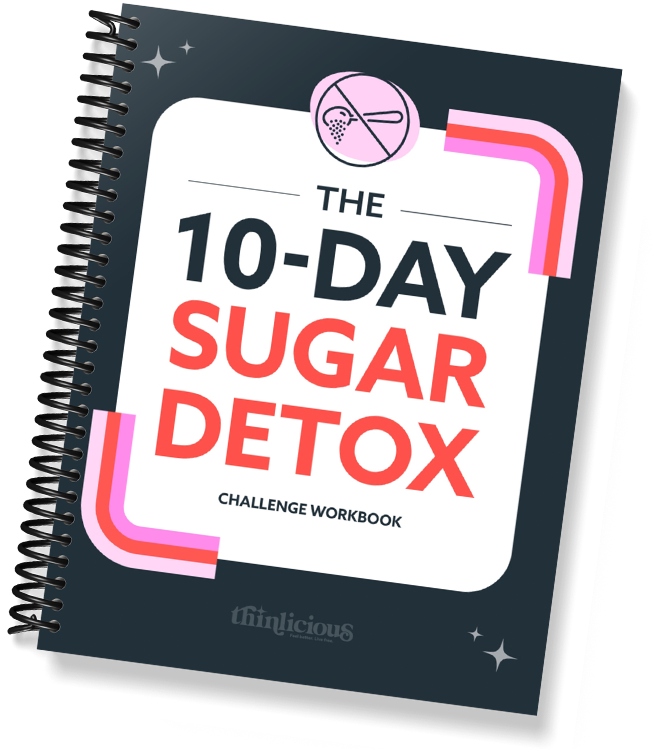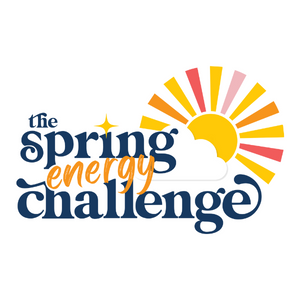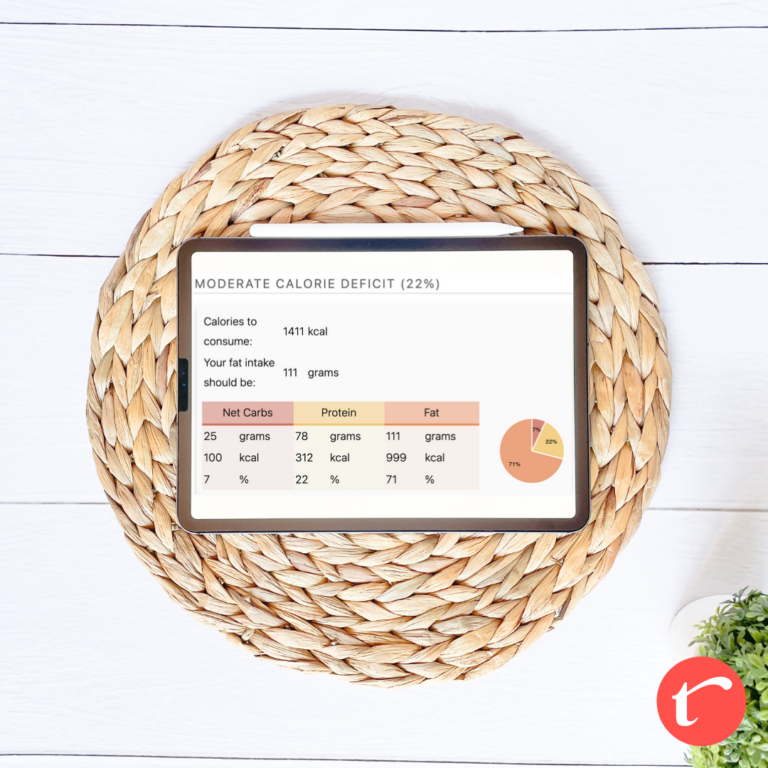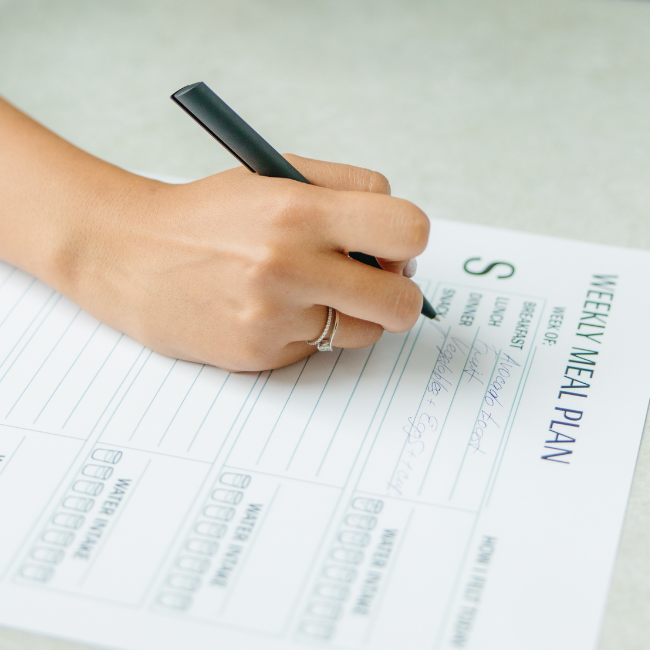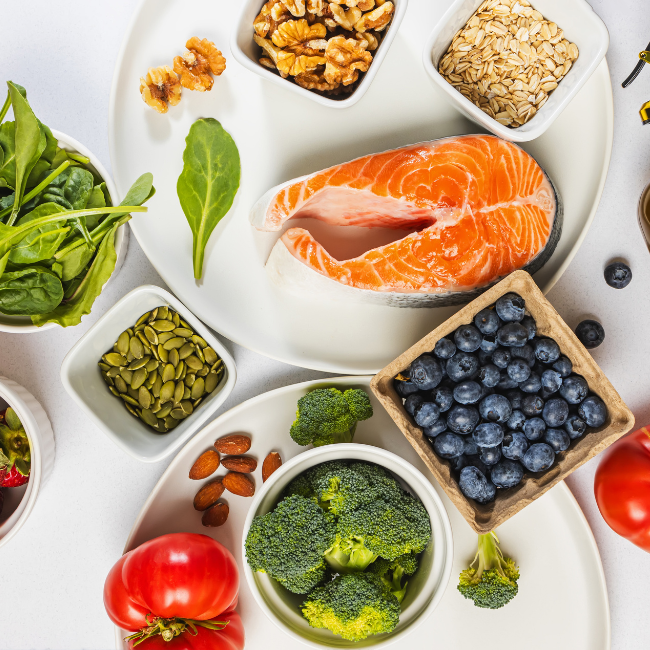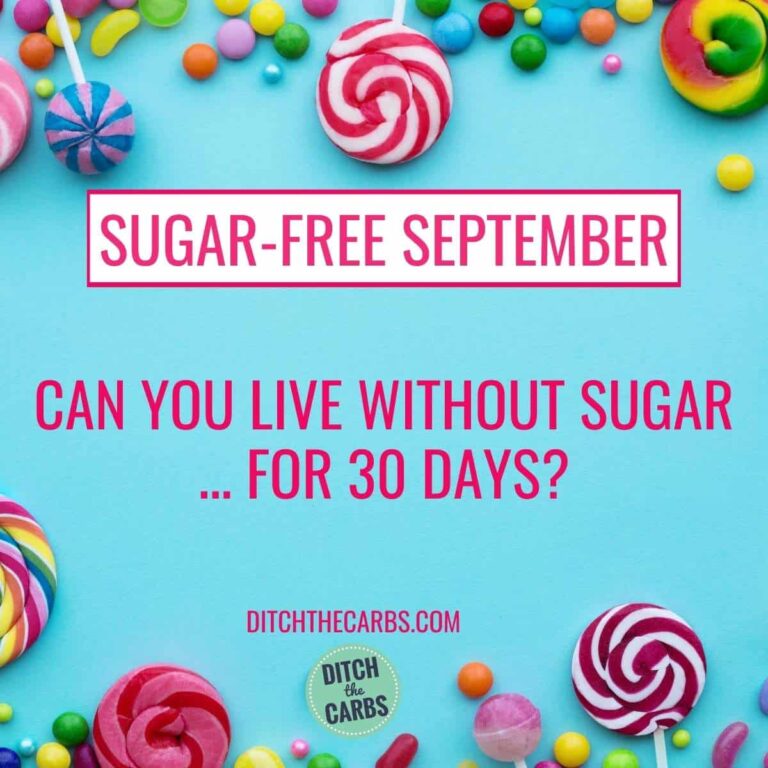You know that feeling when you’re trying to eat healthy and you’re totally crushing it…and then out of nowhere, you’re hit with this irresistible need for something sweet?
And suddenly, it’s ALL you can think about—that donut you saw in the break room, or the pint of ice cream in your freezer, or the leftover halloween candy you hid from your kids.
Welcome to sugar addiction and—news flash—even if your cravings aren’t for sweet things, but other high carb foods like bread or pasta or potato chips—it still comes down to sugar.
The good news is that there IS a way to break free and retrain your brain, which is why in this episode we’re going to take a dive deep into the science of sugar addiction, and talk about what’s really going on in your body and your brain when you consume sugar, and how you can use that knowledge to your advantage to actually RESET your brain and get off the sugar rollercoaster for good.
Are you ready to lose weight and heal your body for life (without dieting, drugs, or making yourself miserable)?
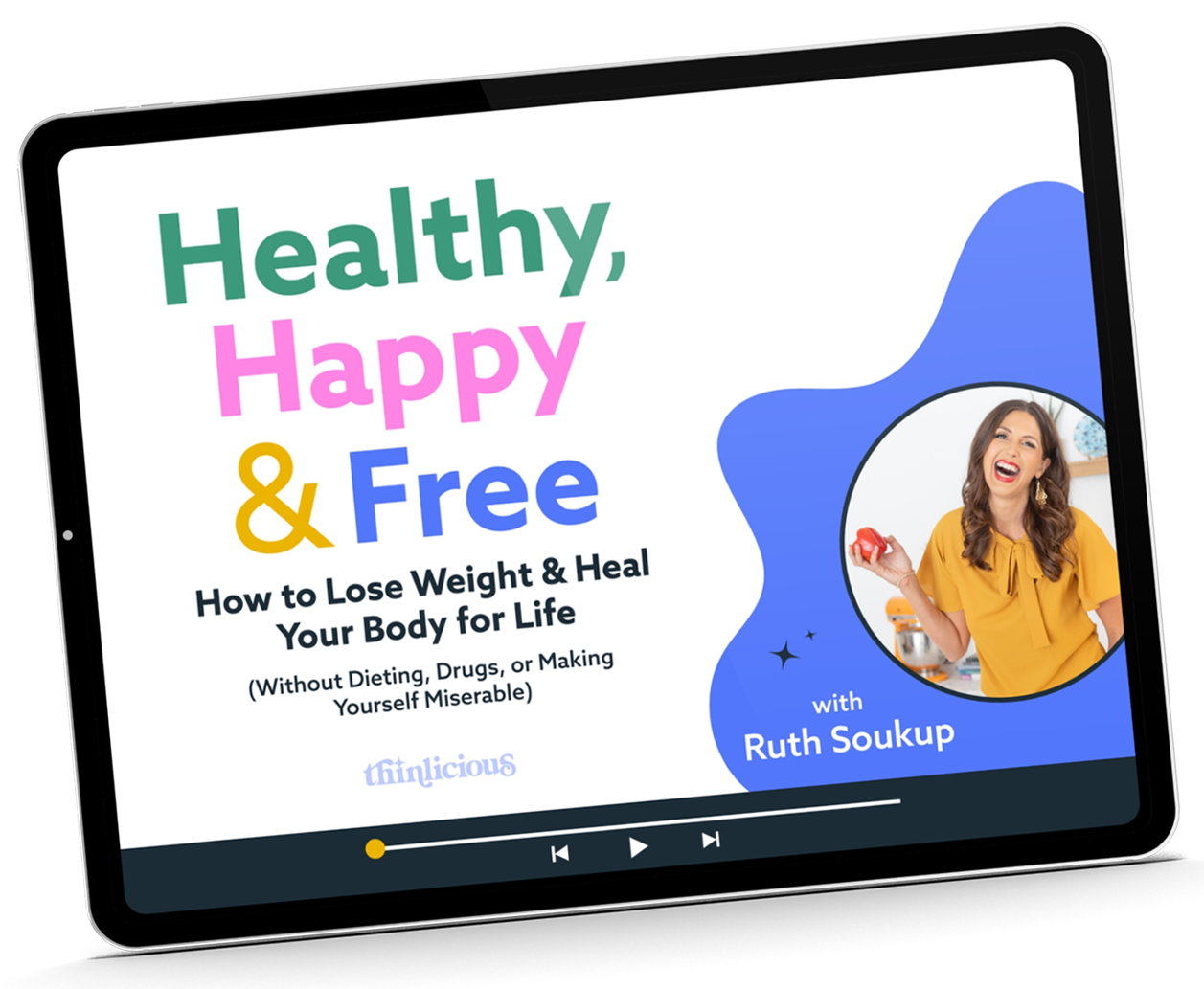
Our free on-demand video training will walk you through how to make this THE year you set health goals…and keep them.
If this is your first time reading the Thinlicious blog, here’s what you should know about me:
I’m a 47-year-old woman who struggled with my weight and health for ten long years, failing at diet after diet, until I finally decided to take a radically different approach.
Instead of starting yet another diet, I started researching.
And I quickly learned that almost everything we’ve ever been told about health and weight loss is totally wrong.
We’ve been lied to for the last 70 years. And it’s had a devastating effect on our health.
So I changed the way I ate.
I stopped focusing on calories and started worrying about HORMONES. And I lost 49 pounds without dieting or Ozempic or making myself miserable, and now I’ve kept that weight off for years.
But that journey changed me.
I’m obsessed with helping women over 40—like you—ditch the crap holding you back and find real freedom through transforming your health.
And today’s topic? It’s personal.
Because I also spent years being a slave to sugar cravings, thinking I just had a “sweet tooth” and that it was totally normal to think about food all the time.
I remember those afternoons when I’d be sitting at my desk, trying to work, but all I could think about was that box of cookies or bag of Doritos lurking in the pantry.
I’d try to ignore it, tell myself I was being good, but eventually I’d cave. And not just have one cookie—I’d eat half the box, or the whole bag of chips, then feel guilty and ashamed for the rest of the day.
Or those nights when I’d finish dinner, feeling satisfied, only to find myself back in the kitchen an hour later, searching for something sweet.
Ice cream, leftover cake, even just a spoonful of peanut butter with honey—anything to satisfy that relentless craving.
Maybe that’s where you are right now. You try so hard to be good, but you always end up back at square one—craving sugar like crazy and feeling totally out of control.
Let me tell you something that might shock you: those aren’t just cravings.
That’s addiction. Real, measurable, scientifically-proven addiction.
And it’s not your fault.
But here’s the thing—once you understand what’s actually happening in your brain and your body, you can finally break free.
So let’s dive in.
But real quick, if you’re new here and you want to learn more about how to actually transform your health without dieting, I’ve got a really good, really powerful free training available for you to watch called Healthy, Happy & Free that walks you through creating your own personalized health plan.
You can grab it HERE.

My Personal Sugar Addiction Story
But before we get into the science, I want to share something with you that I don’t talk about very often—just how bad my sugar addiction really was.
For 28 years, I was a vegetarian. And during that time, I thought I was eating so healthy. I’d start my day with a green smoothie packed with fruit, have a bowl of yogurt for lunch with some “healthy” granola on top, and snack on things like energy bars and dried fruit.
I was so smug about my “healthy” diet.
But what I didn’t realize was that I was consuming massive amounts of sugar all day long.
That green smoothie? Probably 60 grams of sugar, even though it was “natural” fruit sugar. The granola on my yogurt? More sugar. And the yogurt itself? Loaded with sugar.
Those energy bars I thought were so much better than candy bars? Often had more sugar than actual candy bars.
And I was constantly hungry. Constantly thinking about food. I’d finish one meal and immediately start planning the next one.
I thought this was normal. I thought some people were just “food people” and I was one of them.
But the worst part was the afternoon crashes. Every single day, around 2 or 3 PM, I’d hit this wall of exhaustion. I couldn’t think straight, I was irritable, and all I wanted was something sweet to pick me up.
So I’d grab another energy bar, or some dried fruit, or if I was really desperate, I’d run to the coffee shop for a muffin and a sugary latte.
And for about 30 minutes, I’d feel better. But then the cycle would start all over again.
I lived like this for years. Decades, actually. And I had no idea that I was trapped in a cycle of addiction.
It wasn’t until I started researching the science of weight loss and metabolism that I learned what was really happening.
And when I finally understood it, everything clicked into place.
The constant hunger, the cravings, the energy crashes, the inability to lose weight no matter how little I ate—it was all connected. I wasn’t weak or lacking willpower.
I was addicted to sugar, and my body was completely dependent on it for fuel.
And there’s a very good chance that yours is too.
Why Your “Sweet Tooth” Is Actually an Addiction
So let’s just get honest about something that might be hard to hear:
What you think is just a “sweet tooth” is actually a full-blown addiction.
I know, I know. That sounds dramatic. But hear me out.
For years, I told myself I just loved sweets. That it was normal to crave them after every meal. That some people are just “sugar people” and others aren’t.
But then I learned the science, and it blew my mind.
Sugar—specifically fructose—is actually as addictive as cocaine.
I’m not being dramatic here. Studies have shown that lab rats will choose sugar water over cocaine when given the choice. In fact, a 2007 study found that when rats were given a choice between cocaine and sugar water, 94% of them chose the sugar water.
Sugar lights up the same reward pathways in your brain as heroin.
It triggers the release of dopamine in the nucleus accumbens—the same area of the brain that’s activated by addictive drugs.
And here’s the kicker: the food industry knows this.
They’ve spent billions of dollars figuring out the exact “bliss point” of sugar that will keep you coming back for more.
Dr. Michael Moss, in his book “Salt Sugar Fat,” describes how food companies hire teams of scientists whose only job is to find the perfect combination of sugar, salt, and fat that will make their products irresistible.
They call it the “bliss point”—the precise amount of sugar that will trigger the strongest craving response without being so sweet that it turns you off.
Think about it—when’s the last time you binged on broccoli?
Never, right? But how many times have you eaten “just one” cookie and ended up polishing off the whole sleeve?
That’s not a lack of willpower. That’s your brain on drugs.
And it gets worse. Just like with any drug, you develop tolerance.
The more sugar you eat, the more you need to get that same dopamine hit.
This is why people who are addicted to sugar often find themselves eating larger and larger quantities over time.
It’s not because you’re getting “worse” at controlling yourself—it’s because your brain literally needs more of the drug to feel satisfied.
And that’s just the beginning.
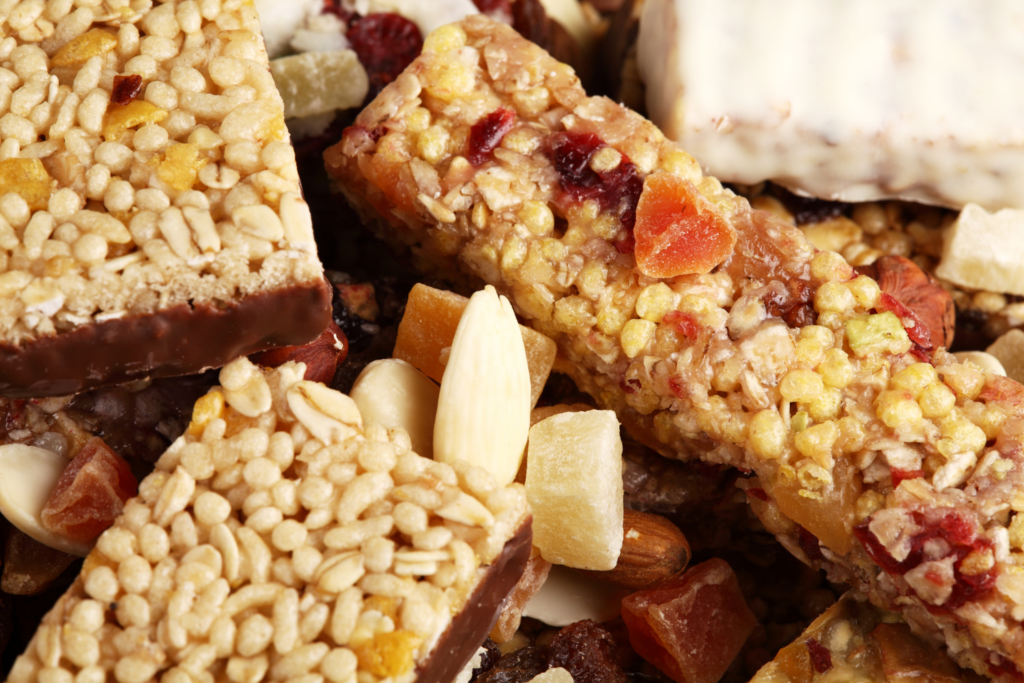
The Hidden Sugar Trap That’s Sabotaging Your Health
But here’s where it gets really sneaky.
You might think, “Well, I don’t eat that much sugar. I don’t have a sweet tooth like some people.”
But sugar isn’t just in the obvious places anymore.
The average American consumes 152 pounds of added sugar per year. That’s almost half a pound every single day. And most of it is hidden.
Let me give you some examples that might shock you:
A single tablespoon of ketchup contains a full teaspoon of sugar.
If you put ketchup on your burger and fries, you could easily be consuming 3-4 teaspoons of sugar without even realizing it.
A cup of flavored yogurt—you know, the kind that’s marketed as healthy—can contain up to 6 teaspoons of added sugar. That’s more than a Twinkie.
A slice of whole wheat bread contains about 2 teaspoons of sugar.
A sandwich made with two slices of bread and some condiments could easily have 6-8 teaspoons of sugar before you even add any “sweet” foods.
A single serving of marinara sauce can contain 3-4 teaspoons of added sugar. If you’re having pasta with sauce, you’re getting a massive sugar hit that you probably don’t even taste as “sweet.”
Even things like salad dressing, protein bars, and supposedly “savory” snacks like crackers and chips are loaded with hidden sugars.
It’s in your bread, your pasta sauce, your salad dressing. It’s in foods marketed as “healthy”—yogurt, granola bars, protein shakes. Even your supposedly “savory” chips and crackers are loaded with it.
And this isn’t by accident.
Starting in the 1970s, when the government started telling us that fat was bad and we should eat low-fat diets, the food industry had a problem. When you take fat out of food, it tastes terrible.
So they solved this problem by adding sugar. Lots and lots of sugar.
They figured out how to extract fructose from corn and add it to literally everything. Because they knew something we didn’t: the more sugar they put in their products, the more we’d buy.
High fructose corn syrup became the cheap, easy way to make low-fat foods taste good. And suddenly it was in everything—bread, crackers, condiments, sauces, even products that weren’t supposed to be sweet.
But here’s what really gets me fired up—the food and diet industries have also managed to convince us it’s our fault. That we just need more willpower. That we’re weak if we can’t resist.
They’ve created a food supply that’s literally designed to be addictive, and then they blame us when we become addicted to it.
That’s complete garbage.
And thankfully, there is a shift that’s starting to happen, with the advent of the Make America Healthy Again Movement.
Companies are finally starting to listen, at least a little bit, and starting to make changes that will hopefully compound over time.
But we still have a long way to go.
What Sugar Actually Does to Your Brain (And Why You Can’t Stop)
So while we wait for the food companies to get their act together, let me explain what’s really happening in your brain when you eat sugar, because I feel like once you understand this, everything changes.
When you consume sugar—especially fructose—it hits your brain like a freight train.
Within minutes, it crosses the blood-brain barrier and floods your system with dopamine, that “feel good” neurotransmitter that gives you an instant high.
Your brain loves this. It thinks, “Ooh, this is good! This helps us survive! Let’s remember this!”
So your brain starts forming what scientists call “reward pathways”—basically, neural highways that connect the consumption of sugar with feelings of pleasure and satisfaction.
The more often you travel these highways, the stronger they become. Eventually, they become so strong that just thinking about sugar, or even seeing it, can trigger intense cravings.
But here’s the really insidious part: the more sugar you eat, the more your brain becomes desensitized to dopamine. So you need more and more sugar to get that same feeling of pleasure and satisfaction.
It’s the exact same process that happens with cocaine or heroin. Your brain literally rewires itself to crave sugar.
Meanwhile, sugar is also wreaking havoc on another part of your brain—the prefrontal cortex. This is the area responsible for decision-making, impulse control, and long-term planning.
Studies have shown that chronic sugar consumption actually shrinks the prefrontal cortex, making it harder for you to make good decisions and resist impulses.
So not only are you becoming more addicted to sugar, but you’re also losing the ability to resist it. It’s a perfect storm.
Dr. Nicole Avena, a neuroscientist who studies food addiction, has shown that sugar affects the brain in four distinct ways:
First, it triggers dopamine release in the reward center, just like drugs do.
Second, it reduces dopamine receptors over time, meaning you need more sugar to feel good.
Third, it affects the brain’s opioid system, which is why sugar can literally make you feel “high.”
And fourth, it impairs the prefrontal cortex, making it harder to make good decisions about food.
And that’s why when you try to cut back, you feel awful.
You get headaches, mood swings, intense cravings, irritability, fatigue, difficulty concentrating. That’s not you being dramatic—that’s actual withdrawal.
The symptoms of sugar withdrawal are remarkably similar to withdrawal from other addictive substances.
In fact, a 2018 study published in the British Journal of Sports Medicine found that sugar withdrawal produces symptoms that are “strikingly similar” to those experienced during withdrawal from drugs of abuse.
I remember when I first tried to cut sugar, I felt like I was losing my mind. I’d be fine all morning, eating my healthy breakfast, feeling good about myself.
Then 3 PM would hit and I’d be desperately searching the office for anything sweet. I’d check every desk drawer, every conference room, even the vending machine, looking for my fix.
I thought I was weak. I thought I just needed more willpower.
Turns out, my brain was just doing what addicted brains do—demanding its fix.
But here’s what no one tells you: this rewiring works both ways.
You can actually retrain your brain to stop craving sugar. It takes time, but it absolutely works.
The Insulin Connection No One’s Talking About
But there’s another piece that’s crucial, especially for women over 40:
Insulin resistance.
See, every time you eat sugar, your body releases insulin to deal with it.
Insulin’s job is to take that sugar out of your bloodstream and either use it for immediate energy or store it as fat.
When you eat sugar occasionally, this system works fine. But when you’re eating sugar all day long—remember, it’s hidden in everything—your body is constantly pumping out insulin.
Over time, your cells get tired of listening to insulin.
They become resistant to its signals. And when that happens, your body can’t effectively process sugar anymore.
So what does your pancreas do? It makes more insulin. And more. And more.
Eventually, you end up with chronically high insulin levels, and this is where everything goes haywire.
When your insulin is high, your body literally cannot burn fat for fuel. Insulin is a storage hormone—when it’s present, your body goes into storage mode, not burning mode.
So now you’re not just psychologically addicted to sugar—you’re metabolically dependent on it too. Your body can only burn sugar for fuel. It can’t access your stored fat for energy.
This is why cutting calories doesn’t work when you’re insulin resistant. Your body literally cannot access your stored fat for energy. It’s like having a full gas tank but the gas cap is locked.
And guess what happens when your blood sugar drops because you haven’t eaten sugar in a few hours? Your body panics and sends you intense cravings for more sugar. It’s the only fuel source it can access.
It’s a vicious cycle, and it’s especially brutal for women over 40 because our hormones are already shifting.
Estrogen helps regulate insulin sensitivity.
As estrogen drops during perimenopause and menopause, insulin resistance gets worse.
Progesterone also plays a role in blood sugar regulation.
When progesterone drops, blood sugar becomes more unstable, leading to more cravings.
Cortisol, our stress hormone, tends to increase as we age.
And cortisol directly contributes to insulin resistance and sugar cravings.
So not only are you dealing with decades of sugar addiction, but your changing hormones are making it even harder to break free.
That’s why you can’t just “eat in moderation” your way out of this. Your body is literally working against you.
And that’s also why traditional dieting approaches—cutting calories, eating “balanced” meals with whole grains and fruit—don’t work for women like us. T
hey keep your insulin high and your body in sugar-burning mode.
The Lies We’ve Been Told About Sugar
Before we get into the solution, I want to address some of the biggest lies we’ve been told about sugar, because these myths are what keep people trapped.
Lie #1 is that “Natural” sugars are better for you.
This is probably the hardest lie to come to grips with, and it’s one I believed for years. I thought that because I was eating dates and agave and honey instead of white sugar, I was making healthy choices.
And the reality is that if your metabolism is functioning properly, natural sugar, eaten in moderation, is totally fine.
But since most of us are walking around with insulin resistance and broken metabolisms, even that natural sugar is problematic.
Because your body doesn’t care if the sugar came from a date or a Snickers bar. Fructose is fructose.
Even fruit, while it does contain vitamins and fiber, is still sugar. And when you’re trying to break free from sugar addiction, fruit can be just as problematic as candy.
Lie #2 is “Everything in moderation.”
This is the most dangerous lie of all, because it sounds so reasonable and balanced. And again, it’s a different story if your metabolism is healthy.
But you can’t be moderately addicted to something.
You can’t smoke cigarettes in moderation if you’re trying to quit smoking. You can’t use heroin in moderation if you’re trying to overcome heroin addiction.
The “moderation” approach keeps you trapped in the addiction cycle.
It’s like telling an alcoholic they can have just one drink a day.
Lie #3 is that “You need carbs for energy.”
This is what I was taught in school, and it’s still what most nutritionists and doctors believe.
But it’s completely wrong.
Your body can make all the glucose it needs through a process called gluconeogenesis.
You don’t need to eat carbs to have energy. In fact, when your body is thin-adapted, you’ll have more stable, sustained energy than you ever did burning sugar.
And finally, lie #4 is that “It’s just about calories.”
This is the lie that kept me trapped for years. I thought if I could just burn off the calories from the sugar I ate, it wouldn’t matter.
But sugar isn’t just calories—it’s a hormone disruptor, a liver toxin, and an addictive substance. The metabolic damage it causes has nothing to do with calories.
These lies are what keep the food industry profitable and keep you sick and addicted.
Don’t fall for them anymore, okay?
The Three-Step Process to Break Free From Sugar Addiction
And now that you understand what you’re really dealing with, let’s talk about how to fix it.
I’m going to give you the exact three-step process that worked for me and has worked for thousands of women in my TAS program.
Step 1 is Commit to a Clean Break
Basically, you need to do a Sugar Detox.
I know this isn’t what you want to hear, but there’s no such thing as “cutting back” on an addiction.
You wouldn’t tell an alcoholic to just drink less wine, right?
Same principle applies here.
The only way to break free from sugar addiction is to eliminate it completely, at least for a period of time.
Now, I’m not talking forever. But your brain needs time to rewire itself, and that can’t happen if you’re still feeding it small doses of the drug.
In our TAS program, we always have people start with a complete sugar detox, where you basically cut all added sugars, all grains, all processed food, and even fruit temporarily.
And we call it a sugar detox for a reason.
I know it sounds extreme. But here’s why it’s necessary:
First, you need to break the psychological addiction. As long as you’re still tasting sweet things, your brain will continue to crave them.
Second, you need to reverse your insulin resistance. The only way to do this is to keep your insulin levels low and stable for an extended period.
Third, you need to retrain your taste buds. When you eliminate sugar completely, foods that didn’t taste sweet before will start to taste sweet. Vegetables will taste more flavorful. You’ll rediscover what real food actually tastes like.
And yes, it’s hard. I won’t lie to you. The first week or two can be rough. You might get headaches, feel cranky, have trouble sleeping, experience brain fog, or feel tired.
But here’s what happens after that: your cravings start to disappear. Your energy levels out. Your mood stabilizes. And you start to feel like yourself again.
I remember the exact moment I realized the sugar had lost its power over me. I was at my daughter’s birthday party, surrounded by cake and ice cream and all her favorite treats. And I just…didn’t want any of it. I wasn’t using willpower to resist—I genuinely had no desire for it.
It was the most liberating feeling I’d ever experienced.
But you can’t get there if you’re still eating “just a little bit” of sugar. The addiction pathways in your brain will stay active, and you’ll continue to struggle with cravings.
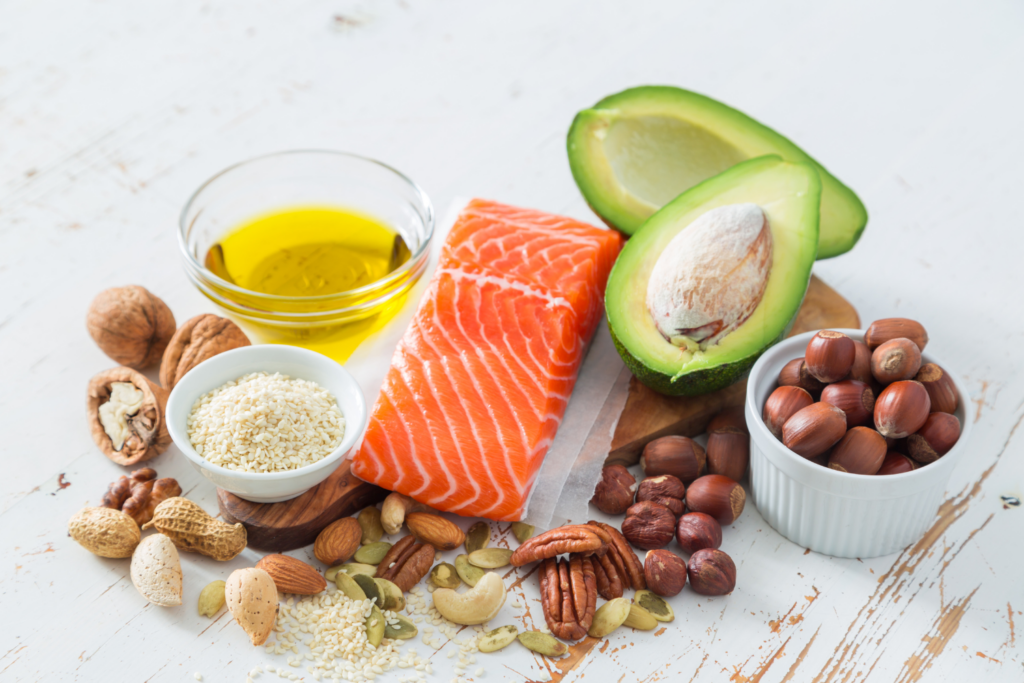
Step 2: Heal Your Insulin Resistance (The Metabolic Reset)
But just cutting out sugar isn’t enough. You also need to heal the metabolic damage that’s been done.
This is where most people get it wrong. They focus on the addiction part but ignore the insulin resistance part.
To truly break free, you need to restore your body’s ability to burn fat for fuel instead of constantly needing sugar.
This means eating in a way that keeps your insulin low and stable. In our TAS program, we focus on:
Protein at every meal. Protein doesn’t spike insulin the way carbs do, and it keeps you feeling full and satisfied. I aim for at least 30 grams of protein at each meal.
Healthy fats. Fat doesn’t trigger insulin at all, and it provides steady, sustained energy. Think avocados, olive oil, nuts, seeds, fatty fish, and grass-fed meat.
Non-starchy vegetables. These provide fiber and nutrients without spiking blood sugar. Leafy greens, broccoli, cauliflower, zucchini, bell peppers.
No grains or processed foods. These all convert to sugar in your body and keep your insulin high.
Intermittent fasting. Giving your digestive system regular breaks helps improve insulin sensitivity.
It sounds restrictive, but here’s what’s amazing: when your insulin is stable, you’re not hungry all the time. You don’t have cravings. You can go hours without thinking about food.
This was the biggest revelation for me. I used to be hungry every 2-3 hours. I’d wake up hungry, eat breakfast, and be hungry again by 10 AM.
Now I can easily go 16-18 hours without eating and feel completely fine. I have steady energy all day. I don’t get hangry. I don’t crash in the afternoon.
I eat more food now than I ever did when I was dieting, but I weigh 49 pounds less than I used to. Because my body is finally working the way it’s supposed to.
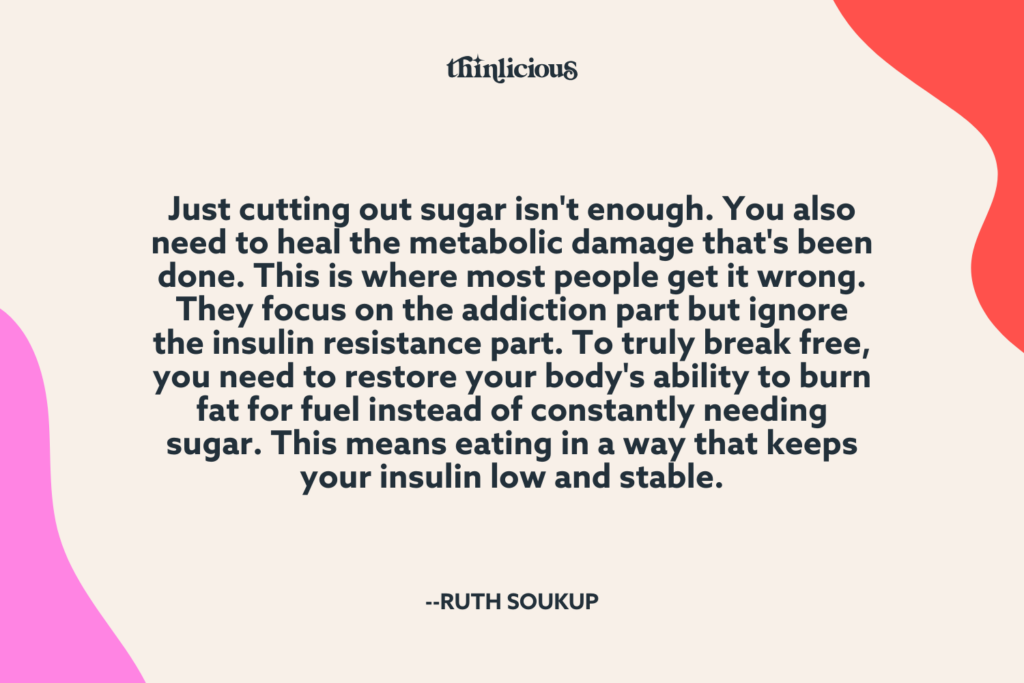
Step 3: Retrain Your Brain (The Mindset Component)
The third step is retraining your brain to find pleasure and reward in things other than food.
This was huge for me. I had to learn new ways to cope with stress, celebrate victories, and comfort myself when things got tough.
For years, food had been my go-to for everything. Happy? Let’s celebrate with cake. Sad? Ice cream will make me feel better. Stressed? Chips and wine will help me relax. Bored? Let’s see what’s in the pantry.
I had to consciously create new habits and new neural pathways.
Instead of reaching for food when I was stressed, I started going for walks outside. The combination of movement, fresh air, and vitamin D was way more effective at reducing my stress than any food ever was.
Instead of celebrating with food, I started treating myself to new workout clothes, a massage, or something else that made me feel good about myself.
When I was bored, instead of mindlessly snacking, I started doing things that actually engaged my brain—reading, working on a puzzle, calling a friend.
It felt weird at first. But slowly, my brain started forming new neural pathways. New habits. New ways of being.
And now? I honestly don’t miss the old way. I don’t feel deprived. I feel free.
The key is to be intentional about this.
You can’t just eliminate the old habits—you have to replace them with new ones.
What to Expect During Your Sugar Detox
So if you decide to try this Sugar Detox approach, here’s what you can expect during the first few weeks:
Days 1-3 are basically The Crash. And this is usually the hardest part. You might feel tired, cranky, or headachy. You might have trouble concentrating. Just know that this is normal—your body is adjusting to running on fat instead of sugar.
Days 4-7 are the Adjustment. You’ll start to feel a bit better, but you might still have some cravings. This is when a lot of people give up, but if you push through, it gets much easier.
In week 2 is when your first Breakthrough usually happens. Most people start to notice significant improvements by the second week. Your energy levels stabilize, cravings diminish, and your sleep improves.
By week 3-4 you’ve hit your New Normal By this point, most people feel dramatically better. Your cravings are mostly gone, your energy is steady, and your mood is more stable.
Beyond 4 weeks is when you really start to feel the Freedom After about a month, you’ve essentially rewired your brain and healed your metabolism. You’ll have steady energy, stable mood, and very few cravings.
But remember, everyone is different. Some people feel better within a few days, while others take a few weeks. Don’t get discouraged if your timeline doesn’t match someone else’s.
And know too, that at Thinlicious, we have an amazing mini-program to help you with this. It’s called the 10 Day Sugar Detox, and it’s awesome. If you want to try it, I’ll include the link in the show notes, so be sure to check that out.
The Real Truth About “Moderation”
Before we wrap up, I want to address something that always comes up when I talk about this: moderation.
People love to say, “Everything in moderation!”
Like that’s some wise, balanced approach to eating.
But the thing about moderation is that it really doesn’t work for addiction.
You can’t be moderately addicted to heroin.
You can’t smoke cigarettes in moderation if you’re trying to quit.
And you can’t eat sugar in moderation if you’re trying to break free from sugar addiction.
I know this is hard to hear, especially in our culture that’s obsessed with “balance.” But sometimes the most balanced thing you can do is eliminate something that’s harming you.
The “moderation” approach is actually what keeps most people trapped.
They’ll eat really well for a few days, then have “just a little” sugar as a treat. But that “little bit” reactivates all the addiction pathways in their brain, and they’re right back where they started.
And I’m not saying you can never have a piece of cake again. Once you actually heal your metabolism and reverse insulin resistance, you’ll find that you can actually add in a moderate amount of sugar and carbohydrates.
But that takes a while–for most women, it will be at least a year to fully heal your metabolism and become we what we call metabolically flexible.
And the only way to get there is to first break the addiction. You need to get to a place where you’re choosing to have cake, not feeling compelled to have it.
There’s a huge difference between those two things.
Once you’ve broken free from the addiction—once you’ve rewired your brain and healed your metabolism—then you can make conscious choices about when and if you want to include sugar in your life.
But if you’re currently addicted, moderation will just keep you trapped.
What Freedom Actually Looks Like
So what does life look like on the other side of sugar addiction?
For me, it’s incredible.
I wake up with energy that lasts all day. I don’t think about food constantly. I can go to parties and social events without feeling stressed about what I’ll eat.
I can walk past a bakery without feeling compelled to go in. I can have treats in my house without obsessing over them. I can make decisions about food based on what will make me feel good, not based on cravings I can’t control.
Most importantly, I feel like myself again. The real me. Not the version that was controlled by cravings and mood swings and energy crashes.
I have mental clarity I haven’t had in years. My mood is stable. I sleep better. I have more patience with my kids. I’m more productive at work.
And this isn’t just my experience. In our TAS program, I see women break free from this every single day.
Take Jodi, one of our clients. She came to us after 20 years of being what she called a “sugar addict.” She’d tried everything—portion control, “mindful eating,” Weight Watchers, you name it. Nothing worked.
She told me she would literally plan her entire day around her next sugar fix. She’d eat a healthy breakfast, then spend the whole morning thinking about what sweet treat she could have for lunch. She’d try to distract herself with work, but her brain was constantly occupied with food thoughts.
She was embarrassed to admit that she would sometimes eat dessert for breakfast, or hide candy in her car so her kids wouldn’t see her eating it.
Within 30 days of starting our program, her cravings were gone. Not reduced—gone. She told me it felt like someone had flipped a switch in her brain.
Now, six months later, she’s down 45 pounds and says she can’t even remember the last time she craved something sweet. She has steady energy all day, sleeps better, and feels like herself again.
This is what’s possible when you understand what you’re really dealing with and take the right steps to address it.
Your Next Step
If you’re ready to break free from sugar addiction, here’s what I want you to do.
First, stop telling yourself it’s just a “sweet tooth” or that you need more willpower. You’re dealing with a real addiction, and it deserves to be treated like one.
Second, make a decision. Are you ready to commit to doing what it takes to break free? Because I won’t lie to you—it’s not easy. But it’s absolutely worth it.
And third, get support. You don’t have to do this alone. In fact, trying to do it alone is one of the main reasons people fail.
That’s why I created the TAS program—to give women the tools, the support, and the community they need to finally break free from food addiction and transform their health for good.
Our program isn’t just about cutting out sugar. We give you meal plans, recipes, shopping lists, and step-by-step guidance to make the transition as easy as possible.
We also provide coaching and community support, because having people who understand what you’re going through makes all the difference.
If you want to learn more about how TAS works and whether it might be right for you, go watch that free training I mentioned HERE. I’ll walk you through the science behind what we do and show you exactly how to create your own personalized plan for getting healthy.
Because here’s what I know for sure: you don’t have to live your life controlled by cravings. You don’t have to feel powerless around food. You can break free.
I did it. Thousands of other women have done it. And you can too.
Final Thoughts
Breaking free from sugar addiction isn’t just about losing weight or getting healthy—though those things absolutely happen.
It’s about reclaiming your power. It’s about feeling like yourself again. It’s about having the energy and confidence to pursue your biggest goals and dreams.
It’s about freedom.
And you deserve that freedom, my friend. You really do.
So don’t let anyone tell you it’s just about willpower or that you need to eat sugar in moderation. You know the truth now. Sugar is a drug, and you’ve been addicted to it.
But addiction isn’t a life sentence. It’s just your starting point.
Your transformation starts now.
Alright friends, that’s a wrap for today.
If this blog post opened your eyes or helped you understand something new about your own relationship with food, I’d love it if you’d share it with someone who needs to hear it.
And don’t forget to grab that free training HERE—it really will change the way you think about health and weight loss.
What if you could actually take control of
your health in just 10 days?
It’s not your fault you can’t lose weight as a woman over 40 even though you’ve likely tried literally everything. Your metabolism probably feels broken and your hormones are likely all out of whack.
But you can fix it all with ONE simple change: eliminate sugar. We make it super easy with daily lessons teaching you the science behind what makes us gain weight in our midlife and beyond! Are you ready to get started now?

